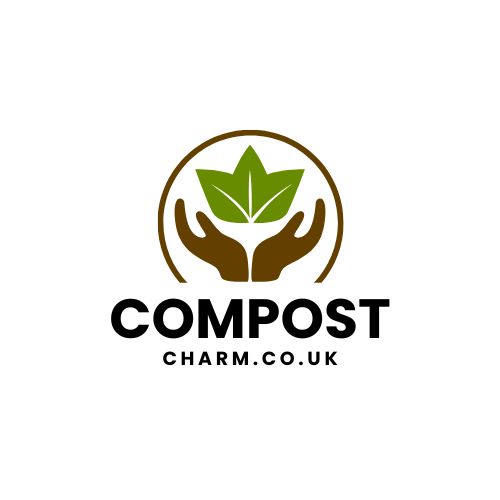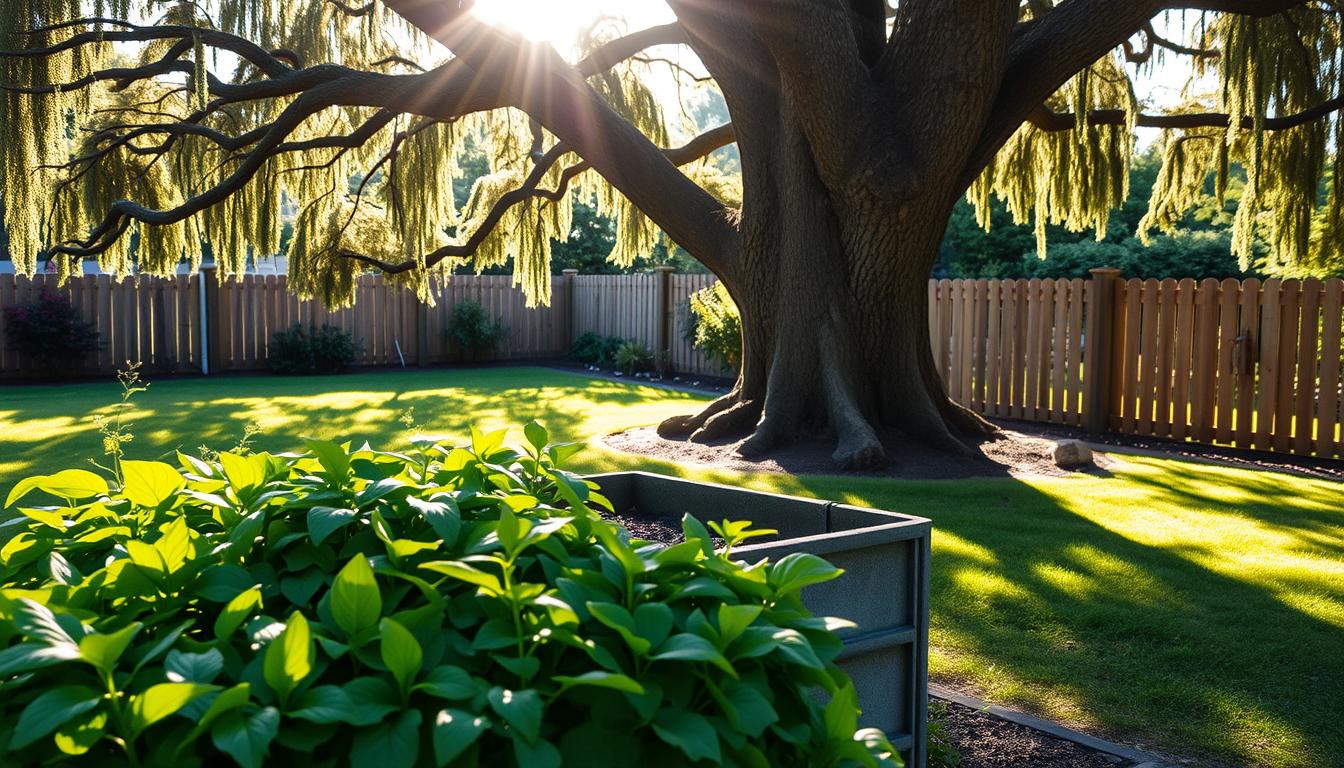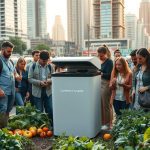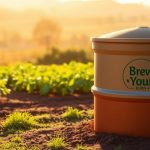Composting is a natural process that turns organic materials into a nutrient-rich soil amendment.
By composting at home, we can reduce our waste output and create a valuable resource for our gardens.
This process involves breaking down organic materials by naturally occurring bacteria and fungus in the soil.
As we adopt this eco-friendly practice, we not only reduce the amount of waste sent to landfills but also improve soil health.
Composting at home is an essential practice for households looking to live more sustainably.
Key Takeaways
- Composting reduces waste output
- Creates a nutrient-rich soil amendment
- Improves soil health
- Supports sustainable living
- Reduces landfill waste
What Are the Benefits of Composting?
Composting is a simple yet effective way to reduce waste, create nutrient-rich soil, and support a healthier environment.
By composting, we can significantly reduce the amount of organic waste sent to landfills, decrease the production of greenhouse gases, and create a valuable resource for our gardens.
Reducing Your Environmental Footprint
One of the most significant composting benefits is the reduction of our environmental footprint.
Composting helps divert organic waste from landfills, where it would otherwise decompose and produce methane, a potent greenhouse gas.
According to research by PhD students in Environmental Health Sciences, composting significantly cuts down on the amount of trash in landfills and reduces the costs and carbon emissions associated with hauling and processing waste.
“Composting is a critical strategy for reducing waste and mitigating climate change.”
Creating Free, Nutrient-Rich Soil
Composting also provides us with a free and natural way to create nutrient-rich soil for our gardens.
By turning kitchen scraps and yard waste into compost, we can improve soil structure, increase the soil’s water-holding capacity, and provide essential nutrients for plant growth.
This not only enhances the health and productivity of our gardens but also reduces our reliance on synthetic fertilizers.
Building a Sustainable Lifestyle
Adopting composting practices is a step towards building a more sustainable lifestyle.
It encourages a culture of waste reduction and recycling, promoting a healthier relationship between our daily lives and the environment.
By composting, we contribute to a closed-loop system where waste becomes a valuable resource, supporting a more circular and sustainable economy.
| Composting Benefits | Environmental Impact | Gardening Advantages |
|---|---|---|
| Reduces landfill waste | Decreases methane emissions | Creates nutrient-rich soil |
| Conserves water | Reduces the need for synthetic fertilizers | Improves soil structure and drainage |
| Supports sustainable living | Mitigates climate change | Boosts plant growth and yield |
The Environmental Impact of Home Composting
As we adopt home composting, we take a significant step towards minimizing our environmental impact.
Home composting is a straightforward practice that offers numerous benefits, from reducing the amount of waste sent to landfills to conserving water and reducing greenhouse gas emissions.
Diverting Organic Waste from Landfills
Food scraps and yard waste together make up more than 30 percent of what we throw away, and could be composted instead, as noted by the US EPA.
By composting these organic materials at home, we can significantly reduce the volume of waste sent to landfills.
This not only helps in managing waste more effectively but also reduces the production of methane, a potent greenhouse gas, in landfills.
Reducing Methane Emissions
When organic waste decomposes in landfills, it produces methane due to the lack of oxygen. By composting this waste in our backyards, we allow it to decompose aerobically, significantly reducing methane emissions.
This simple action can contribute to a reduction in greenhouse gas emissions, helping to combat climate change.
Conserving Water and Preventing Erosion
Composting also plays a crucial role in conserving water and preventing soil erosion.
Compost can improve the soil’s water-holding capacity, reducing the need for frequent watering and minimizing soil erosion caused by runoff.
This is particularly beneficial in areas prone to drought or heavy rainfall.
Let’s examine the environmental benefits of composting in a more detailed manner:
| Environmental Benefit | Description | Impact |
|---|---|---|
| Reducing Landfill Waste | Diverting organic waste from landfills | Decreases methane production |
| Conserving Water | Improving soil’s water-holding capacity | Reduces watering needs |
| Preventing Erosion | Enhancing soil structure | Minimizes soil loss |
By understanding the environmental impact of home composting, we can appreciate the significance of this practice in contributing to a healthier environment.
As we continue to explore the benefits of composting, it becomes clear that this simple habit can have a profound effect on our planet.
Garden and Plant Benefits of Homemade Compost
The benefits of homemade compost for gardens and plants are multifaceted, ranging from improved soil structure to enhanced disease resistance.
By using compost, we can create a more sustainable gardening practice that not only enriches the soil but also supports the overall health of our plants.
Improving Soil Structure and Drainage
Homemade compost adds organic matter to the soil, improving its structure and drainage capabilities.
This results in a nutrient-rich soil that can better retain moisture and nutrients, benefiting our plants.
Boosting Plant Growth and Yield
Compost is rich in nutrients that are essential for plant growth.
By incorporating compost into our soil, we can boost plant growth and yield, leading to healthier and more productive gardens.
Creating Natural Disease Resistance in Plants
One of the most significant benefits of using compost is its ability to create natural disease resistance in plants.
This is achieved through several mechanisms:
How Compost Suppresses Plant Pathogens
Compost contains beneficial microorganisms that can suppress plant pathogens, reducing the need for pesticides and other chemicals.
As noted by PhD students in Environmental Health Sciences, “Compost enriches the soil with nutrients, which reduces the need for fertilizers and pesticides.”
Building Stronger Plant Immune Systems
By enriching the soil with compost, we can help build stronger immune systems in our plants, making them more resilient to disease and pests.
This approach not only benefits our gardens but also contributes to a more sustainable and environmentally friendly gardening practice.
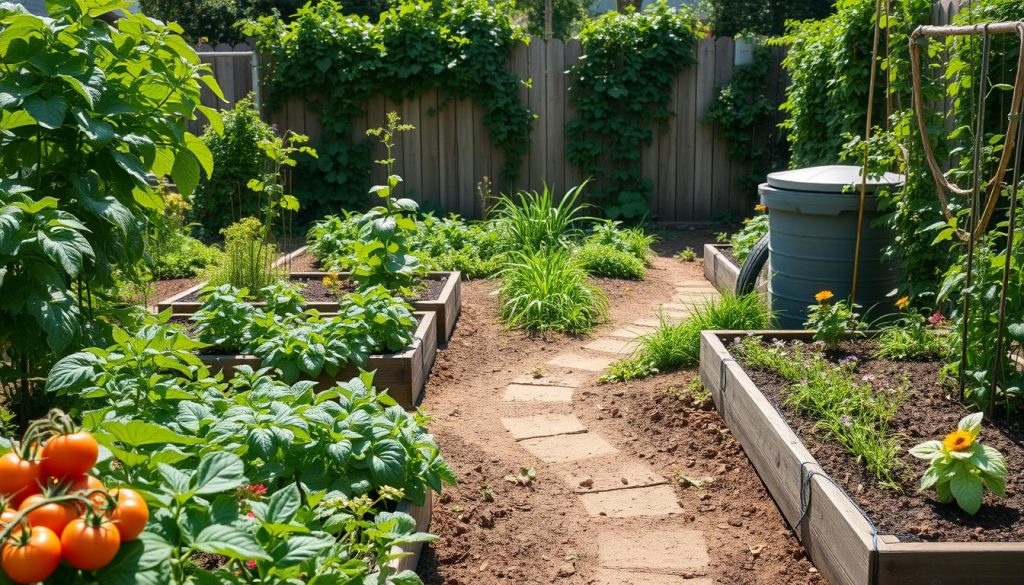
As we continue to explore the benefits of homemade compost, it becomes clear that this simple practice can have a significant impact on our gardening success and the health of our environment.
Economic Advantages of Creating Your Own Compost
By composting, individuals can reduce their expenses on fertilizers, waste management, and water bills.
This practice not only contributes to a more sustainable lifestyle but also offers several financial benefits.
Eliminating the Need for Store-Bought Fertilizers
Composting at home allows you to create your own nutrient-rich fertilizer, thereby reducing the need to purchase expensive fertilizers from stores.
Homemade compost is rich in nutrients and can improve soil health, which in turn boosts plant growth and yield.
Reducing Your Waste Management Costs
Effective composting can significantly reduce the amount of waste sent to landfills, thereby lowering waste management costs.
By managing organic waste at home, we can decrease the financial burden associated with waste disposal.
Saving Money on Water Bills
Compost can improve the soil’s water retention capacity, reducing the need for frequent watering. This not only saves water but also lowers your water bills.
According to data, composting can lead to significant savings on water bills over time.
Here’s a summary of the potential economic benefits of composting:
| Economic Benefit | Description | Potential Savings |
|---|---|---|
| Eliminating Store-Bought Fertilizers | Creating your own nutrient-rich fertilizer | Up to $100/year |
| Reducing Waste Management Costs | Lowering waste disposal costs through composting | Up to $50/year |
| Saving on Water Bills | Improving soil water retention | Up to $20/year |
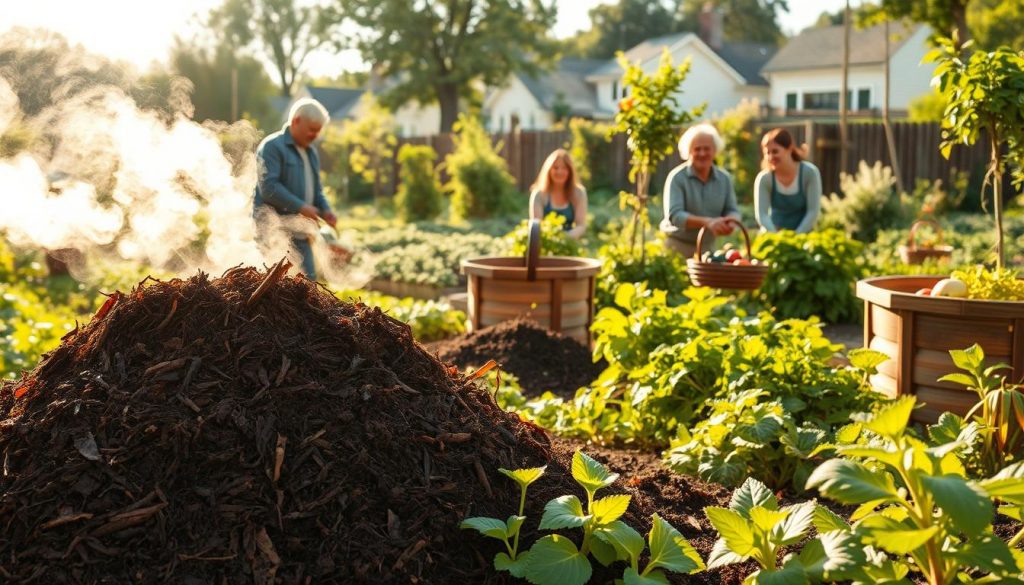
By adopting composting practices, we not only contribute to a healthier environment but also enjoy the economic advantages it offers.
It’s a simple yet effective way to make a positive impact on our wallets and the planet.
How to Start Composting: Materials and Methods
Embarking on a composting journey begins with understanding the various methods and materials at your disposal.
Composting is not a one-size-fits-all process; it can be tailored to suit different spaces and needs.
Whether you have a spacious backyard or a small indoor area, there’s a composting method that’s right for you.
Choosing the Right Composting System for Your Space
Selecting the appropriate composting system is crucial for successful composting.
The choice largely depends on the space available and the type of waste you plan to compost.
Outdoor Bin Systems
Outdoor bin systems are ideal for those with yard space. They come in various sizes and can be made from different materials such as plastic, metal, or wood.
These bins help in keeping the composting process neat and tidy.
Indoor Vermicomposting
Indoor vermicomposting, or worm composting, is perfect for small spaces. It involves using red wiggler worms to break down food scraps into a nutrient-rich compost.
This method is odorless and can be done in a basement or under the sink.
Bokashi Fermentation
Bokashi fermentation is another indoor method that uses microorganisms to ferment food waste.
It’s a fast process and can handle a wide variety of kitchen scraps, including meat and dairy products.
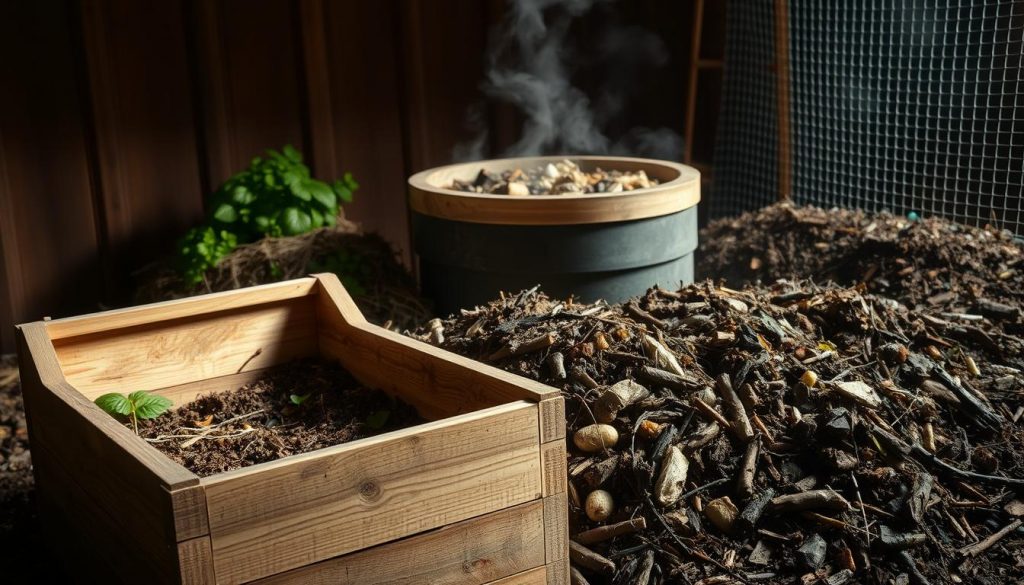
Essential Tools for Successful Composting
While composting can be done with minimal equipment, having the right tools can make the process more efficient.
Essential tools include a compost turner, aerator, and a moisture meter.
| Tool | Description | Benefit |
|---|---|---|
| Compost Turner | A long-handled tool used to turn the compost pile. | Eases the process of aerating the compost. |
| Aerator | A tool that helps in introducing oxygen into the compost. | Speeds up the decomposition process. |
| Moisture Meter | A device that measures the moisture level in the compost. | Helps in maintaining the optimal moisture level. |
Understanding Green and Brown Materials
A crucial aspect of composting is balancing green and brown materials. Green materials are rich in nitrogen and include kitchen scraps and grass clippings.
Brown materials are rich in carbon and include dried leaves and straw. A mix of 2/3 brown materials and 1/3 green materials is generally recommended.
By understanding the different composting methods and materials, you can create a sustainable gardening practice that benefits both your garden and the environment.
Step-by-Step Guide to Building Your First Compost Pile
Creating your first compost pile is a simple yet effective way to divert organic waste from landfills and enrich your garden soil.
By following a few straightforward steps, you can turn kitchen scraps and yard waste into a valuable resource for your garden.
Finding the Ideal Location
The first step in building your compost pile is selecting the right location. Ideally, you want a spot that is dry, shady, and close to a water source.
This location should also be easily accessible to make regular maintenance simpler.
Avoid areas that are too close to your house or neighbors, as they might be affected by potential odors.
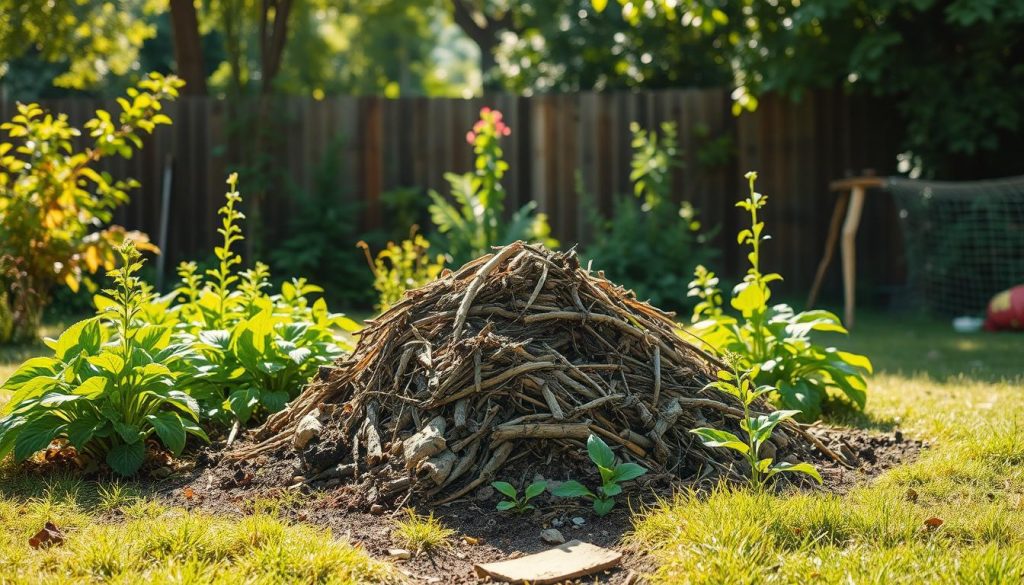
Layering Materials Properly
To build a compost pile, start by layering brown materials (such as dried leaves or straw) at the bottom.
This helps with airflow and carbon-rich foundation. Next, add a layer of green materials (like kitchen scraps or grass clippings), which are rich in nitrogen.
Continue alternating between brown and green layers, ending with a brown layer on top.
Maintaining the Correct Carbon-to-Nitrogen Ratio
A balanced compost pile requires a mix of carbon-rich (brown) and nitrogen-rich (green) materials.
Aim for a carbon-to-nitrogen ratio of about 25:1 to 30:1. This balance is crucial for efficient decomposition and minimizing odors.
| Material Type | Carbon/Nitrogen Content | Examples |
|---|---|---|
| Brown Materials | High Carbon | Dried leaves, straw, shredded newspaper |
| Green Materials | High Nitrogen | Kitchen scraps, grass clippings, manure |
Turning and Aerating Your Compost
Regular turning of your compost pile is essential to maintain oxygen flow and speed up decomposition.
Use a pitchfork to gently turn the materials, being careful not to compact the pile.
This process should be done every few days to a week, depending on the pile’s size and composition.
Monitoring Moisture and Temperature
Your compost pile should be kept moist, like a damp sponge.
Excessive dryness can halt decomposition, while too much water can lead to anaerobic conditions and unpleasant odors.
Temperature is another critical factor; a healthy compost pile can reach temperatures between 130°F and 140°F, indicating active decomposition.
By following these steps and maintaining your compost pile, you’ll be on your way to creating nutrient-rich soil for your garden while contributing to a reduction in landfill waste.
What Can and Cannot Be Composted
Not all organic materials are suitable for composting, and knowing the difference is key. Composting is an effective way to manage organic waste and create nutrient-rich soil for gardening.
However, including the wrong materials can lead to odor problems, attract pests, and reduce the quality of the compost.
Kitchen Scraps That Enrich Your Compost
Kitchen scraps are a valuable addition to any compost pile. Fresh fruit and vegetable peels are rich in nutrients and help speed up the composting process.
Coffee grounds and tea bags are also excellent additions, as they are high in nitrogen. Eggshells can be included as well; they add calcium and help deter pests.
Yard Waste and Garden Trimmings
Yard waste, such as leaves and grass clippings, is ideal for composting. Leaves are rich in carbon, while grass clippings are high in nitrogen, making them a perfect combination.
Garden trimmings, including dead flowers and branches, can also be composted, reducing waste and creating a nutrient-rich soil amendment.
Household Items You Didn’t Know You Could Compost
Some household items can be composted, reducing the amount of waste sent to landfills. Shredded newspaper and cardboard are good examples; they are high in carbon and help balance out the nitrogen-rich materials.
Hair and fur can also be composted, as they are high in nitrogen.
Materials to Keep Out of Your Compost Bin
Certain materials should be avoided when composting. Meat, dairy, and oily foods can attract pests and create unpleasant odors.
Pet waste can contain pathogens harmful to humans and should not be composted. Weeds with seeds should also be avoided, as they can propagate in the compost and spread in the garden.
By understanding what can and cannot be composted, we can create a more effective and efficient composting process, turning waste into a valuable resource for our gardens.
Troubleshooting Common Composting Challenges
Despite its many benefits, composting can sometimes be plagued by problems that need to be troubleshot.
Whether you’re a seasoned composter or just starting out, understanding how to address these challenges is crucial for maintaining a healthy and productive compost pile.
Eliminating Odors and Deterring Pests
One of the most common issues composters face is unpleasant odors and pests. To eliminate odors, ensure that your compost pile has a good balance of “green” and “brown” materials.
Adding a layer of brown materials like leaves or straw on top can also help absorb odors. To deter pests, avoid adding meat, dairy, or oily foods to your compost.
Fixing a Slow-Decomposing Pile
A slow-decomposing pile can be frustrating, but there are several ways to speed it up. First, check the carbon-to-nitrogen ratio and adjust it if necessary.
You can also try turning the pile to introduce more oxygen or adding a compost accelerator.
Managing Seasonal Composting Issues
Composting can be affected by seasonal changes. During the winter, decomposition slows down due to cold temperatures.
To manage this, you can add more brown materials to insulate the pile. In the summer, ensure that your compost pile doesn’t get too dry by maintaining adequate moisture levels.
Addressing Moisture Problems
Moisture is critical for composting. If your compost is too dry, it won’t decompose properly. On the other hand, if it’s too wet, it can become anaerobic and smelly.
The ideal moisture level is like a damp sponge. You can check the moisture by squeezing a handful of compost; if it feels like a damp sponge, it’s just right.
| Issue | Cause | Solution |
|---|---|---|
| Odors | Too many green materials, not enough brown materials | Add more brown materials, turn the pile |
| Pests | Adding meat, dairy, or oily foods | Avoid adding these materials, bury new additions under existing compost |
| Slow decomposition | Incorrect carbon-to-nitrogen ratio, lack of oxygen | Adjust the carbon-to-nitrogen ratio, turn the pile |
Conclusion: Harvesting and Using Your Finished Compost
After weeks or months of maintaining your compost pile, you’re ready to reap the rewards.
Harvesting your finished compost is a satisfying experience, knowing you’ve created a nutrient-rich soil amendment that’s perfect for sustainable gardening.
To use your compost, simply mix it into the soil or use it as a top dressing for your plants. This will improve soil structure, boost plant growth, and support healthy ecosystems.
Research by Environmental Health PhD students highlights the benefits of composting, including enriching soil and improving plant growth.
By adopting composting practices, you’re not only reducing your environmental footprint but also creating a more sustainable gardening routine.
So, get ready to enjoy the benefits of your labor and watch your garden thrive with the help of your homemade compost.
